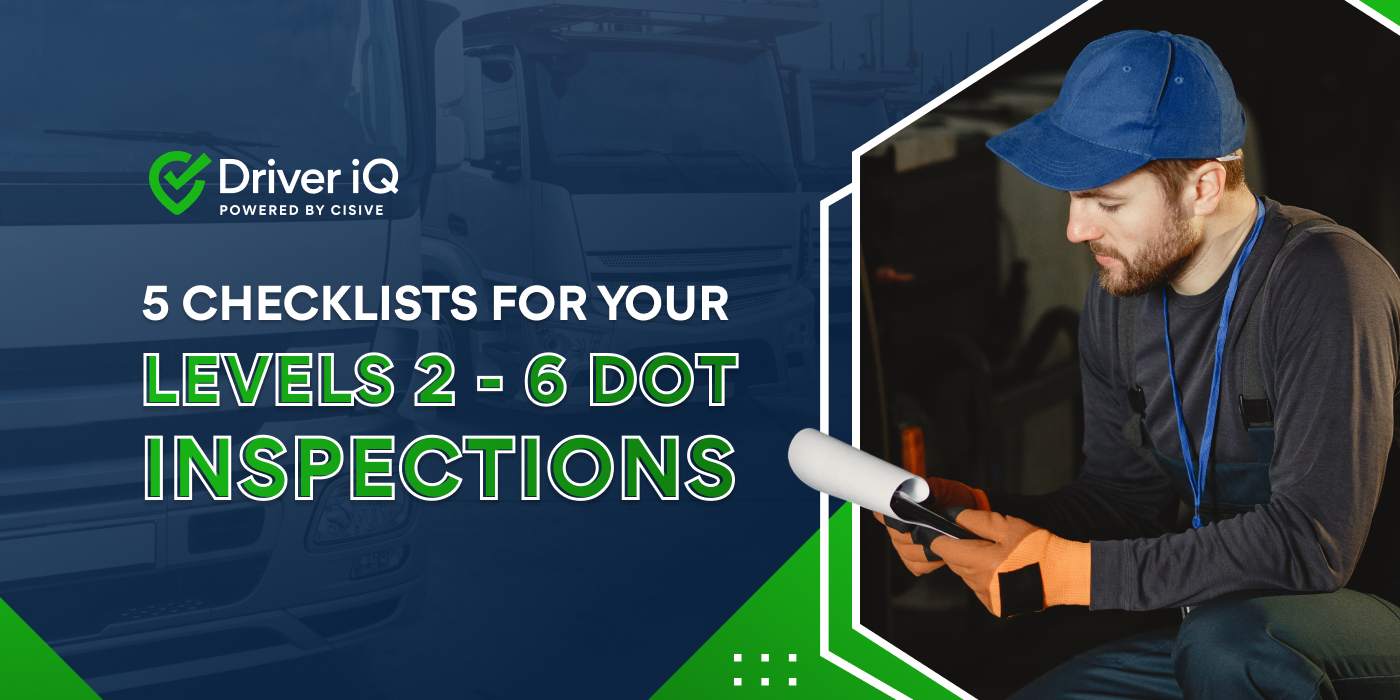
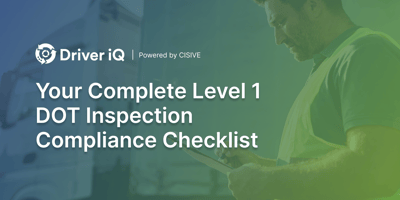
The U.S. Department of Transportation requires regular inspections of all commercial motor...

The Department of Transportation regularly conducts safety inspections on any commercial motor vehicle weighing over 10,000 pounds. These inspections are designed to help keep everyone safe on the road by ensuring both the driver and vehicle are in compliance.
Truck drivers with a commercial driver's license (CDL) can face Level 2-6 DOT inspections anytime, even if they haven’t committed a safety violation. This makes it important for truck drivers and trucking companies to always be prepared for any type of roadside inspection.
There are several things you and your drivers can do to increase your chances of passing the next DOT inspection, such as:
Truck drivers already know how important safety and compliance are on the road. To ensure truckers adhere to all required safety standards, the Department of Transportation conducts frequent inspections.
Every commercial truck weighing over 10,000 pounds must undergo a Level 1 safety inspection at least once a year. Many safety checks are conducted during the Commercial Vehicle Safety Alliance International Roadcheck event. This planned three-day event puts truck drivers on alert and gives them time to prepare.
But what about Level 2-6 DOT inspections? These inspections can happen at any time and without notice. It’s crucial for truck drivers to always be prepared to pass a DOT inspection of any level. This guide provides information pertaining to Level 2-6 DOT inspections and how to prepare for one.
Key Takeaways
|
DOT inspections are roadside safety checks that assess the safety and compliance of commercial vehicles weighing over 10,000 pounds and their drivers.
These inspections are conducted by qualified inspectors from the Department of Transportation or trained state police officers. Depending on the level of the inspection, it could take anywhere from 15 to 60 minutes or longer to complete.
Trucks or drivers out of compliance can face hefty fines and penalties or be put out of service until the violation is corrected. This, in turn, could lead to delivery days and added costs.
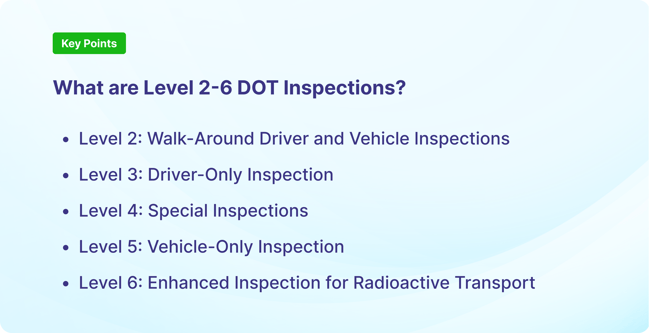
Technically, there are eight DOT inspection levels. As mentioned above, Level 1 DOT inspections are mandatory and must be conducted at least once a year.
Level 7 DOT inspections deal with alternative commercial vehicles, such as buses, taxis, and limousines. While Level 8 DOT inspections pertain solely to vehicles using electronic tracking devices.
For the purposes of this guide, it focuses only on Level 2-6 DOT inspections.
Recommended Reading: Level 1 DOT Inspection Checklist
A Level 2 DOT inspection is similar to a Level 1 safety check, with one exception. The examiner will not physically get under the truck during the evaluation.
Instead, the inspector walks the entire way around the truck while checking all safety components, including lights, tires, brakes, and steering. The inspector or officer also ensures the cargo is tied down properly and the hitch complies with all safety requirements.
The truck driver must also show all required documentation, such as their driver’s license, logbook, carrier identification and status report, and Medical Examination and Skill Performance Evaluation (SPE) report.
Unlike Level 1 and Level 2 DOT inspections, the Level 3 safety check only involves the driver. This type of inspection is most commonly conducted in conjunction with a traffic violation, such as speeding or driving in a restricted lane.
During this inspection, the driver must provide the examiner or officer with all the requested documents, such as their driver’s license, vehicle insurance and registration, Hours of Service (HoS) report, logbook, and if applicable, a previous vehicle inspection report with any relevant receipts and documents.
Level 4 DOT inspections are not very common, but they do occur. It’s a one-time inspection and the least comprehensive type of all DOT safety checks.
During a Level 4 DOT inspection, the officer or inspector only checks for one specific safety feature or issue. These types of inspections are typically done at the request of the Commercial Vehicle Safety Alliance (CVSA) or the Federal Motor Carrier Safety Administration (FMCSA) to gather information pertaining to a study.
A Level 5 DOT inspection is the opposite of the Level 3 safety check. It only verifies safety features on the truck and trailer, not the driver’s information.
This type of DOT inspection is typically used when the driver can’t be there. For example, For example, the driver may have been taken to a hospital following an accident or incarcerated due to a traffic infraction, such as driving under the influence.
While a vehicle-only inspection is often conducted after an accident, the driver may still need to submit to a drug and alcohol test, even if transported to the hospital.
Recommended Reading: When Is FMCSA Post-Accident Drug Testing Required
A Level 6 DOT inspection only pertains to certain commercial vehicles carrying radioactive materials.
Unlike some other types of DOT inspections, drivers know when these safety checks will occur. In fact, drivers transporting radioactive materials on regulated trucks cannot drive on the road until they pass this inspection.
Once approved, the inspector will attach a special sticker to the truck that remains in place until the radioactive material reaches its destination. At that point, the sticker is removed.
The best way to pass a Level 2-6 DOT inspection is to be prepared. Pre-trip inspections of your truck, trailer, and paperwork are imperative.
Below is a checklist to help you make sure you have everything in place, no matter what type of DOT inspection you encounter.
A Level 2 DOT inspection requires a safety check of the vehicle and the driver. This means all your paperwork must be in place and your truck must pass all required safety standards.
It will include a check of various aspects of your truck and driver information, including:
A Level 3 DOT inspection only involves a check of the driver’s credentials and qualifications.
The officer or inspector will likely ask to review a variety of documents, including:
Since Level 4 DOT inspections typically focus on just one safety feature, it can be hard to prepare for it. The best way you can prepare for this type of safety check is to make sure that all safety elements examined during a Level 2 DOT inspection are in good working condition.
A Level 5 DOT inspection only involves a visual assessment of the truck and trailer.
During this inspection, the driver’s information is not reviewed because the truck operator is not typically available.
Since you won’t be available to provide any feedback to the inspector or officer, it’s crucial that your vehicle’s safety features and systems are in good working condition.
This type of inspection can include an assessment of various parts of the vehicle and trailer, including:
All commercial vehicles carrying transuranic (TRU) waste and highway route controlled qualities (HRCQ) of radioactive materials are required to pass a level 5 DOT inspection before starting their trip.
When transporting dangerous materials, a comprehensive inspection including all elements of a North American Standard Level 1 inspection may be necessary.
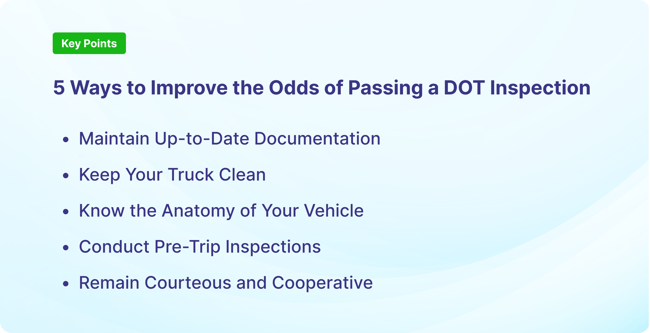
Due to the importance of DOT inspections, they can be very stressful, even for seasoned truck drivers. However, you can improve your odds of passing DOT inspections by taking proactive steps and knowing how to interact with the inspector during an inspection.
As a truck driver, you know exactly what documents you’re required to keep. An inspector or officer can ask to check these documents at any time.
If you want to pass your next DOT inspection, it’s crucial to keep these documents as up-to-date as possible. You should also keep these documents and logs in one location to make them easily accessible when needed.
Keeping your truck cabin clean allows inspectors to check for safety compliance quickly. It also makes it easier to find the information and documents you need.
As a truck driver, it's essential to know how to identify all major elements of your vehicle. This understanding makes it easier for you to converse with the inspector and better answer any questions they might have.
Pre-trip inspections are a must. Every time you get ready to take your truck on the road, you should conduct a quick walk-around to ensure everything is in good condition.
This step not only increases your chances of passing a DOT inspection, but it can help you identify potential issues with your truck. Finding any issues early gives you a chance to make simple repairs before they become more costly.
Never be combative with an inspector or officer. This can certainly jeopardize the outcome of the inspection and cause you even more trouble.
Instead, remain courteous at all times and provide the officer with any documents or information requested.
Recommended Reading: Recruiting Truck Drivers
Once the DOT safety check is complete, the inspector or officer will go over the results and provide you with a Driver Vehicle Examination Report (DVER). This report includes all the inspection details, including any violations or suggestions.
You must provide your employer with a copy of this DVER report and also keep a copy with your Driver Qualification Files. These reports are filed with the Department of Transportation and could impact your or your employer's CSA (Compliance, Safety, Accountability) scores.
If the inspector notes any violations of safety standards either with your truck or driver records, you might face various consequences. For instance, the inspector could just give you a warning or issue a fine and other penalties.
Depending on the type of violation, you or your vehicle could be marked as out-of-service until the safety violation is corrected. This means you can’t drive the vehicle until you take care of the issues.
For example, if your tires didn’t pass the safety test, you may need to replace them with new tires before you can get back on the road.
Repeated violations can lead to hefty fines, a suspension of your driving license, or a suspension of your employer's commercial license.
Understanding how Level 2-6 DOT inspections work helps alleviate some stress. Additionally, taking proactive steps to keep your truck and trailer in good working condition and your paperwork in order can go a long way in ensuring you pass your next DOT inspection.
Driver iQ can help you find qualified drivers who understand the components of Level 2-6 DOT inspections. This step can help improve your company’s chances of passing these inspections on the road and maintaining an acceptable CSA score.
Experienced truck drivers understand the various vehicle components and know how to conduct proper pre-check inspections. They also know what type of documentation and paperwork to keep and how to maintain it properly.
Speak to an expert today to learn more about our Driver iQ services.
Author: Michael Kapuschinsky
Bio: Product Manager with more than a decade of experience in the transportation industry.
Let's Connect on LinkedIn
The U.S. Department of Transportation requires regular inspections of all commercial motor...
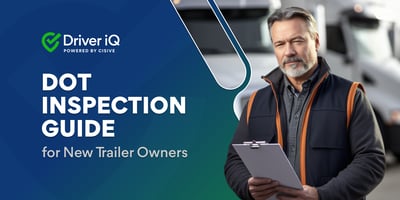
Owning and operating a new trailer can be an exciting experience. However, it’s important to...
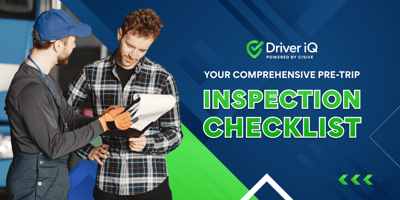
Pre-trip inspections are an everyday task for most Commercial Driver's License (CDL) drivers....